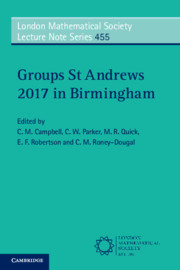Book contents
- Frontmatter
- Contents
- Introduction
- Finite Simple Groups and Fusion Systems
- Finite and Infinite Quotients of Discrete and Indiscrete Groups
- Local-Global Conjectures and Blocks of Simple Groups
- A Survey on Some Methods of Generating Finite Simple Groups
- One-Relator Groups: An Overview
- New Progress in Products of Conjugacy Classes in Finite Groups
- Aspherical Relative Presentations all Over Again
- Simple Groups, Generation and Probabilistic Methods
- Irreducible Subgroups of Simple Algebraic Groups – A Survey
- Practical Computation with Linear Groups Over Infinite Domains
- Beauville p-Groups: A Survey
- Structural Criteria in Factorised Groups Via Conjugacy Class Sizes
- Growth in Linear Algebraic Groups and Permutation Groups: Towards a Unified Perspective
- L2-Betti Numbers and their Analogues in Positive Characteristic
- On the Pronormality of Subgroups of Odd Index in Finite Simple Groups
- Vertex Stabilizers of Graphs with Primitive Automorphism Groups and a Strong Version of the Sims Conjecture
- On the Character Degrees of a Sylow p-Subgroup of a Finite Chevalley Group G(pf) Over a Bad Prime
- Patterns on Symmetric Riemann Surfaces
- Subgroups of Twisted Wreath Products
- Some Remarks on Self-Dual Codes Invariant Under Almost Simple Permutation Groups
- Test Elements: From Pro-p to Discrete Groups
- References
Test Elements: From Pro-p to Discrete Groups
Published online by Cambridge University Press: 15 April 2019
- Frontmatter
- Contents
- Introduction
- Finite Simple Groups and Fusion Systems
- Finite and Infinite Quotients of Discrete and Indiscrete Groups
- Local-Global Conjectures and Blocks of Simple Groups
- A Survey on Some Methods of Generating Finite Simple Groups
- One-Relator Groups: An Overview
- New Progress in Products of Conjugacy Classes in Finite Groups
- Aspherical Relative Presentations all Over Again
- Simple Groups, Generation and Probabilistic Methods
- Irreducible Subgroups of Simple Algebraic Groups – A Survey
- Practical Computation with Linear Groups Over Infinite Domains
- Beauville p-Groups: A Survey
- Structural Criteria in Factorised Groups Via Conjugacy Class Sizes
- Growth in Linear Algebraic Groups and Permutation Groups: Towards a Unified Perspective
- L2-Betti Numbers and their Analogues in Positive Characteristic
- On the Pronormality of Subgroups of Odd Index in Finite Simple Groups
- Vertex Stabilizers of Graphs with Primitive Automorphism Groups and a Strong Version of the Sims Conjecture
- On the Character Degrees of a Sylow p-Subgroup of a Finite Chevalley Group G(pf) Over a Bad Prime
- Patterns on Symmetric Riemann Surfaces
- Subgroups of Twisted Wreath Products
- Some Remarks on Self-Dual Codes Invariant Under Almost Simple Permutation Groups
- Test Elements: From Pro-p to Discrete Groups
- References
Summary
We survey some recent results on test elements of pro-p groups and discrete groups. An element g of a group G is a test element of G if every endomorphism of G that fixes g is an automorphism. Our main focus is on pro-p techniques in the study of test elements of discrete groups. In particular, we discuss the distribution of test elements in free groups and surface groups.
- Type
- Chapter
- Information
- Groups St Andrews 2017 in Birmingham , pp. 486 - 501Publisher: Cambridge University PressPrint publication year: 2019
References
- 1
- Cited by



